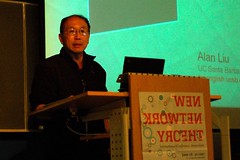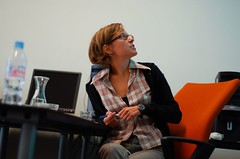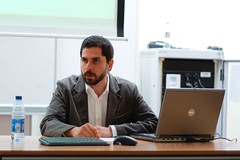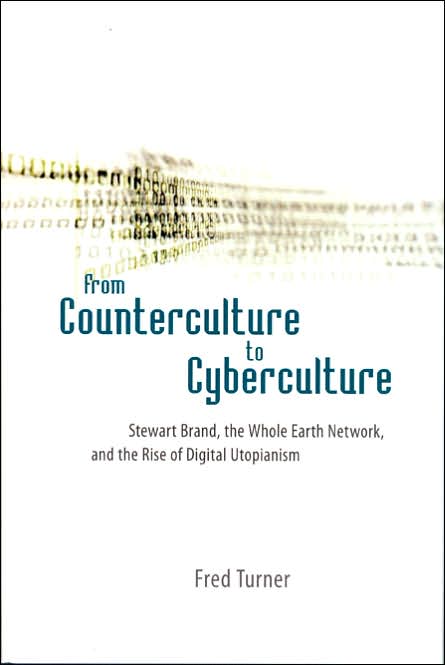Olympic Athlete Blogs: Expressing Opinion or Journalism?
The International Olympic Committee (IOC) is considering lifting the ban on athletes blogs during the Olympic Games. A rule in the Olympic charter states that it is forbidden for athletes to partake in journalism whilst competing in the Olympics, but now the big question is being raised if blogging is, in fact, journalism.

“In principle, the commission is not against, but it’s quite a delicate issue and we decided to investigate a little bit more,” said Athletes commission chairman and former Olympic pole vaulter Sergei Bubka. Adding that blogging is “… a modern way for people who want to express their opinion, but we believe there should be certain rules (censorship???) respected by every athlete who participates in the Games and who is living in the (Olympic) village.” (http://news.yahoo.com/s/afp/20070207/tc_afp/iocolyathletes)
Bubka also raised questions of privacy and, probably most importantly, conflicts with media and tv rights. It looks like the IOC fears that “conventional journalism” (the media companies who have big expensive contracts with the IOC) will be challenged by people journalism, or in this case, athlete journalsm…
Nate Harrison is a media theorist / artist, whose work deals with remix culture and the related issues of copyright and creativity:
Can I Get An Amen? is an audio installation that unfolds a critical perspective of perhaps the most sampled drum beat in the
history of recorded music, the Amen Break. It begins with the pop track Amen Brother by 60’s soul band The Winstons, and traces the transformation of their drum solo from its original context as part of a ‘B’ side vinyl single into its use as a key aural ingredient in contemporary cultural expression. The work attempts to bring into scrutiny the techno-utopian notion that ‘information wants to be free’- it questions its effectiveness as a democratizing agent. This as well as other issues are foregrounded through a history of the Amen Break and its peculiar relationship to current copyright law.
Nate Harrison’s site with more projects / Can I get an Amen? on Youtube
Ballet & Discipline have always been inseparable, but this link now gets a new meaning.
PANOPTICON is an interdisciplinary performance for three dancers, a musician and video, inspired by Michel Foucault’s Discipline and Punish: the birth of the prison. “Working with mechanisms of power, PANOPTICON uses the theatre to show the different layers of ‘the game of power’, between performers and audience, between play and reality, between disciplines, between indiviual and system, and between image and space.”
Where? Melkweg Theatre, Amsterdam.
When? March 2/3/4; 20.30h
www.melkweg.nl/artikelpagina
www.visisonor.net
www.bodiesanonymous.nl
I’ve seen Stanley Kubricks film adaptation of Stephen Kings thriller ‘The Shining’ many times… I even read the book when I was younger… which I didn’t like too much, however, as it turns out I really missed to grasp the essence of the story; I thought it was about insanity caused by isolation… well, just check this clip:
We have all heard the question “What is new media?” and we often wonder about it ourselves on this blog and elsewhere. The What’s New Media blog also deals with this issue and has recently started a wiki with the same topic.
Students from DePaul University in Chicago, Stanford and NYU have currently written 132 articles and welcome New Media students, academics, nerds, etc. to participate.
So I was browsing around YouTube and stumbled upon this video of McLuhan on the Today Show:
I think presidential debates are indeed exemplary of the adage “The Medium is the Message”. It’s refreshing to see media theory from 1976 still being fully applicable today. I especially love how he claims that what the candidates say is completely irrelevant :)
 I thought I’d just try it, see what happens to myself when I don’t post for a while on my own blog. Although it isn’t that interesting for the readers of a blog, you should definitely try it. Because when a blog becomes a McLuhanesque fixed charge in your life, the only way to see what has changed is to disconnect from it. As you can see, it didn’t last that long before I just couldn’t resist to get back to my blog and write down my thoughts and experiences in this post.
I thought I’d just try it, see what happens to myself when I don’t post for a while on my own blog. Although it isn’t that interesting for the readers of a blog, you should definitely try it. Because when a blog becomes a McLuhanesque fixed charge in your life, the only way to see what has changed is to disconnect from it. As you can see, it didn’t last that long before I just couldn’t resist to get back to my blog and write down my thoughts and experiences in this post.
So there’s a documentary by the British Channel Four which argues that human/CO2 caused Global Warming is a pile of steaming bollocks (smells better than excrement). It can grow to become a kind of counter-Inconvenient Truth, and contribute to reversing the progress the Global Warming movements have so far achieved.
While there are plenty of sites who dispute the science in this documentary (see here, here and here) I would like to take some time to address the ad hominem remarks made in the film. It provides a great deal of focus on what an industry the Global Warming hype is; scientists who support the dominant theory because of the money and jobs it gets them. There is an argument made that the movement is part of a plot to inhibit the development of Third World countries, and that there is a lot of political power to go around in advancing the Global Warming story.
Regarding the argument that supposedly scientists are in it for the money, I’ve made a screenshot of a selection I made on exxonsecrets.org of most of the scientists appearing in the documentary who are making a buck out of being GW deniers (Click to enlarge):
I get that there is a lot of greed to go around. The point seems moot however. Both GW deniers and GW alarmists have plenty of opportunity to make a buck. Somewhere between those two, there must be some proper science. So far, the documentary comes across as far too smeary and self satisfied.
Why is this relevant? I used an interactive visualization to attack one of the pillar arguments of the GGWS documentary. Of course, one must realize that my screenshot itself is an ad hominem argument; simply by associating these scientists with Exxon-Mobile funded institutions implies that these scientists are lying through their teeth for big dollars. In the end, my effort does nothing to discredit their actual scientific arguments. The difference between the documentary and me is that I recognize ad hominem tricks for what they are :p
 Room F201C of the University of Amsterdam’s Oudemanhuispoort building for an hour was the domain of Fiona Raby. She presented her ideas on design, which has close links to the design practice of Anthony Dunne, together they’re also known as the duo Dunne & Raby. It is a vision on design that is not of technological futuristic visions, but of the fragile people, but still not pessimistic and depressing, but optimistic. Below is my account of the presentation.
Room F201C of the University of Amsterdam’s Oudemanhuispoort building for an hour was the domain of Fiona Raby. She presented her ideas on design, which has close links to the design practice of Anthony Dunne, together they’re also known as the duo Dunne & Raby. It is a vision on design that is not of technological futuristic visions, but of the fragile people, but still not pessimistic and depressing, but optimistic. Below is my account of the presentation.
Why do I feel a need to blog daily? There seems to be some kind of consensus or norm in the blogosphere that blogs should be updated daily. Several blogs about blogging recommend posting daily and blog search engine Technorati’s rankings are correlated to a blog its freshness. There is both an internal and an external “perceived freshness fetish” (Rogers, 2007) in the blogosphere. The internal freshness fetish could be described as a wish, a personal demand or a wanting to blog daily. The external freshness fetish could be described as a requirement by external parties like Google and Technorati to blog daily to achieve a certain ranking. This external freshness fetish is further imposed by using ping techniques to let services such as Technorati know that you have updated your blog.
 Can Network knowledge improve? The second New Network Theory session starts with this question from Alan Liu in his presentation Network Knowledge: Policing Web 2.0.
Can Network knowledge improve? The second New Network Theory session starts with this question from Alan Liu in his presentation Network Knowledge: Policing Web 2.0.
Alan’s aim today is to present a draft proposal for a non-reactionary policy for regulating and improving Web 2.0 knowledge. In doing so, he’s opening up the can of worms that is the Wikipedia debate.
(Read more and discuss below..)
 Rob Stuart is an activist based in Philadelphia. Here he gave an overview of some of his work, especially that which made use of new technologies. In this way he gave conference-goers some network practice to go along with the theory.
Rob Stuart is an activist based in Philadelphia. Here he gave an overview of some of his work, especially that which made use of new technologies. In this way he gave conference-goers some network practice to go along with the theory.
His first case study drew comparisons between the railroad and the new media network. Railroad operators have traditionally been able to lay down the law, enabling movement for some while restricting that of others. An affordance of the new networks, on the other hand, is citizen action. A meeting between old and new occurred in Philadelphia, when railroad companies attempted to close off the Schuylkill River Park Trail.
 The first round of parallel sessions is underway, and a crowd has gathered in a computer lab at the Media studies department to discuss ‘the link’.. A preview comes in the form of one participant’s notes, where I spotted the question, in bold, “What about Google?!”
The first round of parallel sessions is underway, and a crowd has gathered in a computer lab at the Media studies department to discuss ‘the link’.. A preview comes in the form of one participant’s notes, where I spotted the question, in bold, “What about Google?!”
![]()
![]()
(more…)
 Ulises A. Mejias offers us a network critique in the final talk of the parallel session ‘Network and Subjectivities.’ In his talk about ‘Hyperlocality and the tyranny of nodes’ he argues that we can see a shift in the way we see networks. First networks were used as metaphors but now networks are used as models to organize sociality.
Ulises A. Mejias offers us a network critique in the final talk of the parallel session ‘Network and Subjectivities.’ In his talk about ‘Hyperlocality and the tyranny of nodes’ he argues that we can see a shift in the way we see networks. First networks were used as metaphors but now networks are used as models to organize sociality.
Mejias addresses four questions in his talk:
- What does nearness feel like when mediated by the network?
- How is subjectivity shaped by the network?
- To what extent are we able to influence the architectures of social participation of the network?
- What are the blind spots in the network and what do these blind spots signify? (more…)

[cross-posted at default settings]
What follows is a summary and review of Fred Turner’s book, From Counterculture to Cyberculture: Stewart Brand, the Whole Earth Network and the Rise of Digital Utopianism.
Nerd Politics?
A recent Ask Slashdot piece appeared with the headline, “Why are so many nerds libertarians?” The interrogator suggests this is linked to the incompatiblity of Leftist ideals and high incomes, but a more likely answer can be sensed further down the thread (far below the funny let’s-mock-Ayn-Rand’s-stilted-prose detour):
“[T]his is the core of libertarian thought: if I’m not hurting you, leave me the hell alone. Don’t tell me what to do. Don’t order me to attend your schools. Don’t take my money for your causes. Let me trade freely (for example, let me buy sugar from Cuba). Let me read, or view, or say, what I want. I don’t need you to tell me what to do; I’m quite capable of figuring it out for myself. Let me have sex with any adult I want, male or female (n.b. I’m quite straight, but I see no reason to surpress other adults’ desires; I’m still protective of minors). Let me put into my body what I choose to put in it.
[…]
Why are so many nerds libertarian? Because you can’t code by rote. You can’t create or develop a new application following someone else’s rules. It requires individual thought, individual judgement, and individual spirit – exactly the same qualities that caused you to be either bored to tears, or jeered at, or socially ostracized at school. So when you finally come to political awareness, and realize that the GOP and the Dems are two sides of the same coin – both of them take your money, lie to you, and shove crap down your throat, while they live high on the hog on your dime (I’m not going to say which side is worse; to me, they’re both squalid), you’re eager to find a personal philosophy that avoids their traps. Libertarians are basically socially progressive and financially conservative. It seems like a logical philosophy, and we’re basically logical people.”
The author of this comment, Brickwall, suggests the trend is linked to a deep-rooted sense of individualism – thought, judgement and spirit, he says. But where he argues that this mix of ‘socially progressive and financially conservative’ politics is simply ‘logical’, one could take a different route, tracing the history of ‘nerd-politics’ to the odd marriage of Newt Gengrich’s Neo-Conservativism with the pages of Wired circa 1996, and then even further back. In From Counterculture to Cyberculture, Fred Turner does exactly this, arguing convincingly that the libertarian world-view so strongly associated with the Web, as well as the corresponding emphasis on de-regulation and on individual responsibility, is intricately tied to the project begun by a distinctive faction of 1960s counterculture, the group he terms the New Communalists.
In ‘organized networks”, Australian media theorist Ned Rossiter states the urgency for new institutional forms, while ‘the uncertainties of labour and life within network societies and informational economies have all too clearly exposed the limits of prevailing institutional systems and structures’ [Rossiter].
During the past 15-20 years, (western) institutions have experienced profound difficulties in adapting to a non-representational democracy. The translation of institutional democracy into a social-technical form of the Internet has proven to constitute a large amount of problems.
Not stating that the Net is democratic by nature, there is a ‘non-state public sphere’, where ‘ cooperation, sharing, common resources, knowledge, customs, experiences and habits make possible a non-representative democracy that no longer submits to the myths and rituals of sovereignty’ [Virno].
In this non-state public sphere, immaterial labour and moreover, disorganized labour has emerged. Unlike the statement of Hardt and Negri, that due to this ‘transnational’ sphere the influence of the nation-state is diminishing, Rossiter states that national institutions (the state) still has an ‘enormous influence on regulating the movement of people and things’ [rossiter]. The problem is that ‘the state’ is doing this via the old, institutional ways, failing to adept adequately to the new ‘grammar’ of labour and capitol; that of the informational networked age.
(more…)
In this book review the theory and ideas that come forward in the book The Tipping Point by Malcolm Gladwell, will be discussed.
Tipping point: one dramatic moment in an epidemic when everything can change all at once. The Tipping point is a thoroughly worked out book about the factors that play an essential role in the emergence of so called ‘social epidemics’. The book is fun and easy to read since it is packed with interesting ‘Davinci–code-like’ facts and examples of past social epidemics such as the sudden emergence of HIV in the 80-ies, emergences of fashion trends and more. According to Gladdwell the best way to understand sudden emergences is to think of it as if it were epidemics. Why do some ideas and behaviours or products spread like virusses and others don’t?
Social epidemics have three characteristics:
1. They are highly contagious
2. Little causes can have big effects
3. Change happens not gradually but at one dramatic moment
The author states three agents of this kind of change: the Law of the few, The Stickiness Factor and the Power of Context.
 This book is a bundle of theories and case studies which Surowiecki uses to convince the reader that a diverse crowd can come up with better answers and solutions than a single group of experts.
This book is a bundle of theories and case studies which Surowiecki uses to convince the reader that a diverse crowd can come up with better answers and solutions than a single group of experts.
The cases he brings forth vary between downright obvious and fantastically revealing examples. For instance the story about cascades, in which people tend to follow other people merely on the fact that if they think it’s good, it will be worthwhile for me. It’s something we experience everyday: if a restaurant is empty, we will not go there because the food might be awful. Same with the internet and computer applications, if everyone uses Google and Microsoft Powerpoint those have to be pretty good applications, but it does not mean they are best suited for you, it means that they are generally the best options for the majority of the crowd.
There are a tremendous amount of celebrity gossip weblogs on the internet. One that has caught my attention, because of its different approach towards celebrity gossip, is Ecorazzi.com. This weblog is about celebrity gossip involving the environment and other goodwill activities. To analyse this weblog on its usability and content, it is important to point out what their mission statement is:
Ecorazzi exists as a conduit to report on the latest celebrity gossip as it pertains to activism and inspiring change. The word eco is in our name, but more than the environment is supported by those in the spotlight. We also highlight humanitarian efforts, beneficial campaigns, fundraisers and acts of good. In the spirit of fair play, we’re quick to point how who’s slacking and who’s deserving of recognition.’(1)
Ecorazzi.com started in August 2006 by Michael d’Estries and Rebecca Carter, and has been growing since with members from different cities around the world. They claim that this gives them the ability to cover events and stories first hand, as well as they represent different point of views. (more…)
Blogs are increasingly used by not only students, but academics as well. Here, I will analyze the blogs by two academics in the field of media studies; Henry Jenkins and David Bordwell.
Analytical framework
My analytical framework consists of three sections; content, interface, and functionality/tools
For the analysis of the content, I have drawn upon William Kraska’s blogpost, ‘What makes a good blog?’. According to Kraska; focus, personality and reader comments are key to building a successful blog.
Content: focus/personality/reader comments
Starting with Jenkins
Jenkins’blog has a clear focus, and I think that most of the academics intend to stay within their field of knowledge. The focus of the blog is the use of media in popular culture, yet it amounts to a diversified range of topics, from fan culture, gender relations, to analyzing television series.
This gives the reader already an impression of the interests of the blogger. In this case, the personal introduction of the blogger accumulates to this effect (see about Jenkins). The about section seems very strong; it’s divided into the formal qualifications of the blogger e.g. work experience, education, profession; personal interest/hobby; work (published books); and related projects.
Any comments? Yes, at the end of every post, there’s a link to the page where the reader can post a comment. Cons: Most of the blog posts on Jenkins’ site do not have reader’s comments.
(more…)
The Flaming Lotus Girls are a San Francisco-based group of female and male artists collaborating all year round to create exceptional fire art and provide a resource for learning metalworking and other essential shop skills. Mother Serpent is a massive skeletal serpent, 165 feet long coiled around her egg. By pushing buttons, spectators can create bigger flames anywhere along the spine. At the rainy opening night at Robodock, Serpent Mother created so much heat causing the rain never touched ground. (more…)
(more…)
In my MA New Media course New Media in practise, blogs are a prominent subject. Besides blogs in general and everything that has to do with the phenomenon blogging we talk a lot about our class blog. In the first two weeks all MA New Media student are encouraged to think about and discuss the mastersofmedia blog which (hopefully) will eventually result in a drastic redesign and new structure which suits the likes of this years MA students.
An aspect of the (more…)
Scienceblog.com is a blog with scientific articles. I analyse this blog on usability aspects using Jakob Nielsen’s articles Weblog Usability: The Top Ten Design Mistakes and Top Ten Mistakes in Web Design. According to Nielsen these are the principles to reach new readers and respect existing reader’s time constraints.
Weblog Usability
1) Author biographies: According to Nielsen users want to know who is the author of the article. On this blog (more…)
In this post I’m analyzing two blogs that get into new media in ‘the black continent’. The black continent… that’s how Erik Hersman called Africa in one of his personal most loved posts on his blog, the white African. A romantic name for the once so mysterious continent that everyone knew so little about. Butt, while most of African mysteries have been mapped out by modern day science and media (even the whereabouts of the illusive source of the Nile is known) Africa consists to be the black continent, quite literally that is:
africa by night
Africa has a population of approximately 933,448,292 people. That is almost 15% of the world’s total population. Fron those 933,448,292 Africans only 33,545,600
are using the internet. That is only 3.6% of the entire African population. Only 3% of the worlds internet users come from an African country. When we take a longer look at the stats we notice that most of the African internet usage comes from the relatively richer countries in the far north and the far south of Africa(see the stats). This contradicts with the words of Kofi Annan, who said that:
…we must match the powerful new tools with the people who need them most.
(edusite) Because of this contradiction and the impact new media technology (if properly implemented) could have on the third world I chose to write my blog analyse on two blogs that get into new media in Africa.
ANALYZED BLOGS (more…)


